#spelt salad
Photo

Spicy Chicken and Spelt Salad - Salad
This chicken and spelt salad has a spicy soy sauce dressing and is both colorful and zesty.
0 notes
Photo
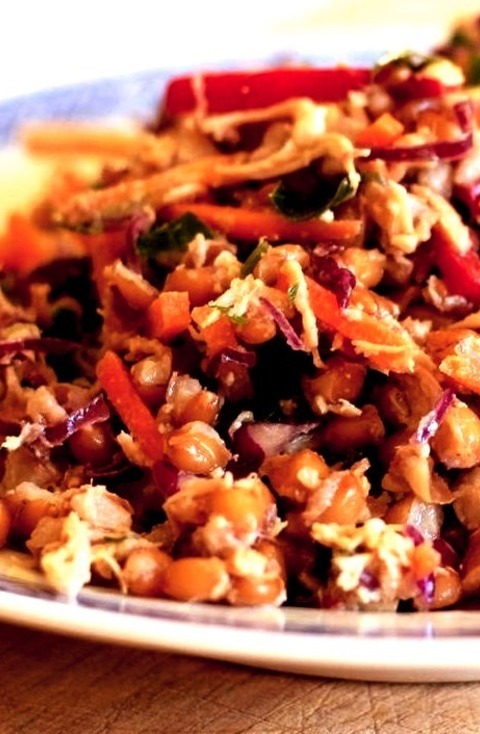
Recipe for Spicy Chicken and Spelt Salad
This is a colorful and wonderfully zippy chicken and spelt salad with a spicy soy sauce dressing.
0 notes
Photo

Spicy Chicken and Spelt Salad - Salad
This chicken and spelt salad has a spicy soy sauce dressing and is both colorful and zesty.
0 notes
Text
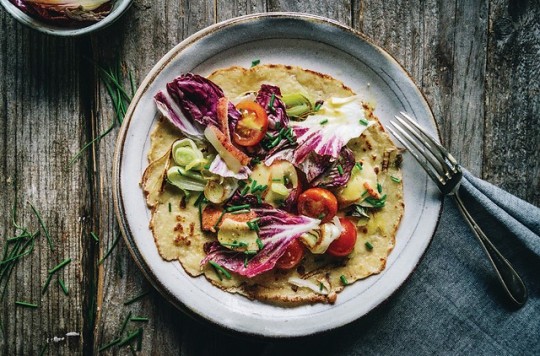
Leek Pancakes with Apple-Radicchio Salad (Vegan)
#vegan#brunch#lunch#pancakes#leeks#salad#apples#radicchio#tomatoes#spelt flour#flax seeds#plant milk#garlic powder#mustard#vinegar#olive oil#chives#black pepper#sea salt#❤
32 notes
·
View notes
Note
Opinion on Cesar salad
M actually not that big of a fan of salads aside from like. A very specific Cobb salad, some strawberry salad, and any salad from Modern Market
Now if you mean “Cesar salad” as in Mr. Torres I have a lot of thoughts on that guy I love him so bad
#the only reason I could imagine you meant Cesar as I’m Cesar Torres#is cause it’s spelt ‘Caesar salad’ LMFAO#Cesar Torres#the mandela catalogue#kitty rambles#asks#anon
4 notes
·
View notes
Photo

Spicy Chicken and Spelt Salad
This is a colorful and wonderfully zippy chicken and spelt salad with a spicy soy sauce dressing.
0 notes
Text
The Spelt Greek salad is a summer recipe with which you can prepare a tasty and colorful dish to serve strictly cold. The Greek spelled salad is perfect for lunch, on the beach or in summer picnics.
We advice you to choose organic vegetables or anyway vegetables of a certain origin to avoid taking harmful substances to the body.
The Spelt Greek Salad is full of seasonal ingredients but, if you want, you can customize it by omitting something or adding a food to your liking.
The Spelt Greek Salad is a dish rich in vitamins, mineral salts and fibers.
#Aperitif#Appetizer#Brunch#FastFood#FastRecipes#FirstDishes#Lunch#Salads#feta#food#greek#greekcuisine#greeklunch#healty#healtyfood#instafood#lightfood#lunch#salad#spelt#summerlunch#tasty#vegetarian#veggie
1 note
·
View note
Text
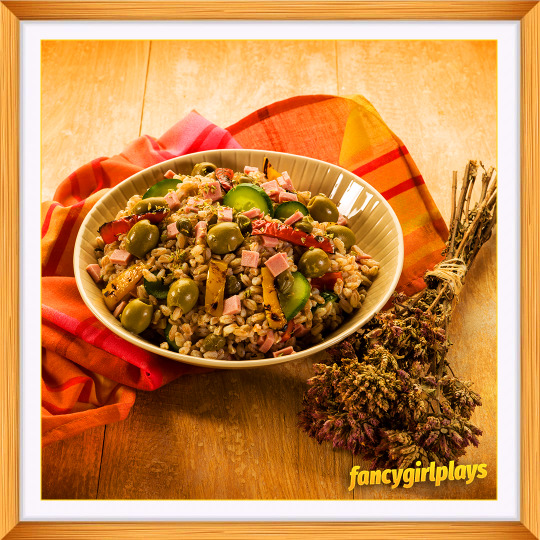
#spelt#cold#salad#olives#zucchinis#mix#mixed#caper#capsicum#pepper#ham#vegetable#wood#bean#bell#brave#diet#dieting#dish#food#grain#green#healty#herbs#napkin#photography#art#interiors#painting#relax
0 notes
Text
For about 10 minutes, a number of Pokémon were spelt incorrectly on Bulbapedia's full list. Then they were spelt correctly again.
Here's a full list of the incorrect spellings, along with Pokédex number and correct spelling.
19
Rat
Rattata
29
Nidoran
Nidoran♀
30
Burned
Nidorina
41
Toothed
Zubat
57
First
Primeape
62
Polyurethane
Poliwrath
77
Pony
Ponyta
82
Magneto
Magneton
84
Dodu
Doduo
85
Lactating
Dodrio
86
rope
Seel
89
In
Muk
95
Onyx
Onix
100
voltorb
Voltorb
118
Ploughing
Goldeen
127
think
Pinsir
128
Bulls
Tauros
141
Finally
Kabutops
161
The center
Sentret
162
oven
Furret
163
hoothoot
Hoothoot
169
He croaks
Crobat
178
shut up
Xatu
193
Do not burn
Yanma
203
giraffe
Girafarig
207
Giggles
Gligar
218
Slum
Slugma
219
Load up
Magcargo
226
keep
Mantine
234
stands
Stantler
239
Eleks
Elekid
251
celebrities
Celebi
259
marshtomp
Marshtomp
262
As Mighty
Mightyena
270
Lottery
Lotad
271
Shadow
Lombre
272
Ludiculous
Ludicolo
283
You bastards
Surskit
290
Ninada
Nincada
304
to
Aron
307
Meditate
Meditite
312
My
Minun
313
Vol beat
Volbeat
322
give name
Numel
324
Torcoal
Torkoal
326
Grumpy
Grumpig
329
Vibrata
Vibrava
334
Altars
Altaria
335
All of them
Zangoose
348
armaldo
Armaldo
361
They snore
Snorunt
363
Sphere
Spheal
371
Wagon
Bagon
375
Methane
Metang
378
Royal
Regice
380
Broads
Latias
400
Come on
Bibarel
406
Budow
Budew
407
Rosed
Roserade
408
Cranids
Cranidos
454
Toxic
Toxicroak
461
We heard
Weavile
464
Faster
Rhyperior
467
magmortar
Magmortar
484
Rewards
Palkia
486
Regulates
Regigigas
489
Phion
Phione
498
Bank
Tepig
504
Square
Patrat
509
I purred
Purrloin
511
Grooming
Pansage
512
We are sage
Simisage
314
Sorry
Simisear
525
Bolder
Boldore
529
Drill cage
Drilbur
531
Cloth
Audino
532
Timber
Timburr
537
Seismic rooms
Seismitoad
548
Petyl
Petilil
549
Lilling
Lilligant
551
We are still
Sandile
552
Crocs
Krokorok
553
To the crocodile
Krookodile
566
Arken
Archen
570
Floor
Zorua
588
Karrablas
Karrablast
594
He smiled
Alomamola
595
From Jolti
Joltik
604
Elektross
Eelektross
605
I'll go
Elgyem
606
Let's be
Beheeyem
629
vullaby
Vullaby
654
Braxen
Braixen
675
On the cart
Pangoro
680
Doubling
Doublade
683
He smelled it
Armoatisse
687
The teacher
Malamar
688
Binnacle
Binacle
690
Scrape
Skrelp
696
Tyrant
Tyrunt
697
A tyrant
Tyrantrum
698
Amura
Amaura
699
Aurora
Aurorus
702
Dead
Dedenne
720
Contact
Hoopa
725
Lit
Litten
738
He was quarrelsome
Vikavolt
754
Lurant
Lurantis
757
Salads
Salandit
760
Claim
Bewear
763
Remembrance
Tsareena
771
Bag
Pyukumuku
774
Miniature
Minior
780
Dramp
Drampa
781
Dhelmis
Dhelmise
784
Come on
Kommo-o
785
Sacred Heart
Tapu Koko
786
Holy Flying
Tapu Lele
788
Kill Finn
Tapu Fini
795
Pheromone
Pheromosa
798
Can
Kartana
800
Necrosma
Necrozma
803
Football
Poipole
807
Zero
Zeraora
821
Rook idea
Rookidee
845
They cry
Cramorant
852
Cobpopus
Clobbopus
854
to believe
Sinistea
857
Hat strap
Hattrem
858
The hatters
Hatterene
862
Obstagon
Obstagoon
872
A dream
Snom
880
He dracozoled
Dracozolt
881
He frowned
Arcozolt
886
Draklos
Drakloak
890
Eternal
Eternatus
891
Big
Kubfu
906
Sprigatite
Sprigatito
914
Anyhow
Quaquaval
916
Oncological
Oinkologne
921
Pawmy
Pawmi
923
Paw motor
Pawmot
929
Doll life
Dolliv
930
tree
Arboliva
933
nacl stack
Naclstack
942
Maship
Masschiff
945
Counts
Grafaiai
957
Tinting
Tinkatink
963
Fizen
Finizen
970
Glimmer
Glimmora
973
flaming
Flamigo
976
Come on
Veluza
977
Dose
Dondozo
983
Speaking
Kingambit
986
Brute Beanie
Brute Bonnet
993
Iron Throat
Iron Jugulis
1016
Let me go
Fezandipiti
152 notes
·
View notes
Text
my favourite safe, low cal meals/snacks as a vegan🐸 (please share yours!!!)
⁃ congee with 30g of rice + veggies/mushrooms + 250ml veg stock, let it cook for like 40mins and then let it sit a bit in the plate, like a porridge. You can add anything to this and switch ingredients.
⁃ seitan skewers —> seitan is SO SO high in protein and so good to me even raw lol, same with tofu.
⁃ block of silken tofu with teriyaki/soy sauce, spices and spring onion —> high in protein, in volume, super simple yet super good, to me its the equivalent of tartare
⁃ tofu scramble —> with the right ingredients and secrets, tofu can be 100% better than eggs. I always hated the texture. Btw I use a little bit of vegan butter, garlic, nutritional yeast, soy milk or melted miso paste, pepper, vegan grated parmesan if I have it and turmeric or saffron.
⁃ tofu with veggies —> I love using red pepper, zucchini, carrots, onion, maybe with origan, black pepper, thyme, curry or paprika
⁃ roasted sweet potato —> I could talk about sweet potato for days. She’s so good cooked in the oven with rosemary, salt, cinnamon, pepper, definitely a safe food.
⁃ soups and pureed soups (I love them with cabbage, pumpkin, mushrooms, i love miso soup, or soups with legumes in it) —> they can be under 100/80 cals and still slap, honestly my salvation when I want to stay under a cal limit or I already reached it but still have to eat something
⁃ hummus of any kind (I recently added sweet potato to it and it blends magically and adds so much volume and flavour!!)
⁃ big salads —> just this, any type. I love a salad with roasted veggies in it or beets and balsamic vinegar
⁃ pan-roasted red cabbage with cannellini dressing —> an easy cannellini puree with some miso paste to blend or some tahini, on top of one or two slices of cabbage cooked in a pan with some oil and maple syrup/marinate sauce
⁃ salted udon/rice noodles with veggies and soy sauce
⁃ ikea vegetable balls (🤤) in marinara sauce
⁃ any vegan burger which is always under 300 cals + some grilled or raw veggies
⁃ tortilla wrap with grilled veggies, tofu, any sauce you like or hummus
⁃ tomato pasta —> simple, lazy, its ok
⁃ chickpea salad with cherry tomatoes, lattuce, pickled onions and pesto tofu dressing
⁃ tortilla-pizza —> under 150 cals and perfect when craving pizza
⁃ chickpea farinata —> again, lazy recipe, so good and rich in protein
⁃ literally anything with rice paper, its so versatile, i love spring rolls
⁃ lentil ragú
⁃ ratatouille
⁃ spelt/orzo with anything, fresh with veggies or cooked in a pureed soup, to make it like a risotto
#an0r3c1a#i wanna be perfect#i wanna be sk1nn1#starv1ng#i wanna relapse so bad#i wanna lose weight#ana meal#m3alspo#me4lspo#me4lsp0#ed meals#mealsp0#low cal meal#low calorie meals#mealspø#meal$p0#starv3#st4rv1ng#st4rv3#low cal restriction#tw restriction#r3striction#skinnyspø#skinnii#skinnyyy#th1nspø#@na trigger#th1gh g@p#thinspø#th1nsp1ration
35 notes
·
View notes
Text
Deutschribing Germany
Cuisine
Meal times
The German proverb Iss dein Frühstück wie ein Kaiser, Mittagessen wie ein König und Abendessen wie ein Bettler (Eat your breakfast like an emperor, lunch like a king, and dine like a pauper) sums up the German outlook toward meals.
A typical day begins with Frühstück (breakfast), when people drink coffee, tea, or hot cocoa and eat muesli with yogurt or milk or bread with butter, jam, honey, chocolate and hazelnut spread, sausage, or cheese. Some people also drink juice and eat a boiled egg. This usually takes place between 6 and 8 a.m. Children usually eat a mid-morning snack at school called Pausenbrot (recess sandwich) that consists of a sandwich, a piece of fruit, or a muesli bar. The adult version is called Zwischenmahlzeit (in-between meal).
Mittagessen (lunch) takes place between 12 and 2 p.m. A typical lunch dish includes potato salad with sausage or meatballs and meat with potatoes or vegetables. It is common for family members and friends to gather between 3 and 5 p.m. for Kaffee und Kuchen (coffee and cake).
Abendessen (dinner) is eaten between 6 and 7 p.m. Sometimes it is a light cold meal with bread and cold cuts, in which case it is called Abendbrot (evening bread). Dinner normally consists of a salad or soup, bread, cheese, meat or sausages, mustard, and pickles.
Dishes
German cuisine varies from region to region, and what is considered typically German is actually typical in the south, mainly Bavaria, where cuisine is similar to that in Austria. There are also international varieties such as doner kebab, pizza, sushi, Chinese food, Greek food, Indian food, and Vietnamese food.
Bread and sausage are staples of the German diet. There are about 600 types of bread and almost 1,500 sausage varieties, including Bratwurst (made of ground pork, beef, or veal and spices) and Weißwurst (white sausage eaten with sweet mustard, a pretzel, and beer).
The national alcoholic drink is beer, of which there are many varieties, including Helles (a pale lager beer produced in southern Germany), Radler (a beer mixed with lemonade), and Weizenbier (a top-fermented beer brewed with a large proportion of wheat relative to the amount of malted barley).
Berliner/Krapfen/Pfannkuchen
These sweet dough dumplings, filled with jam and glazed with powdered sugar, are known as Berliner in northern and western Germany, Pfannkuchen in eastern Germany, and Krapfen in southern Germany.

Birnen, Bohnen und Speck
Birnen, Bohnen und Speck (pears, beans, and bacon) is a dish made with pears, green beans, and bacon, accompanied by potatoes. It is eaten in Bremen and Lower Saxony.

Bratkartoffeln
Bratkartoffeln (fried potatoes) are fried potato slices with diced bacon and/or onions.
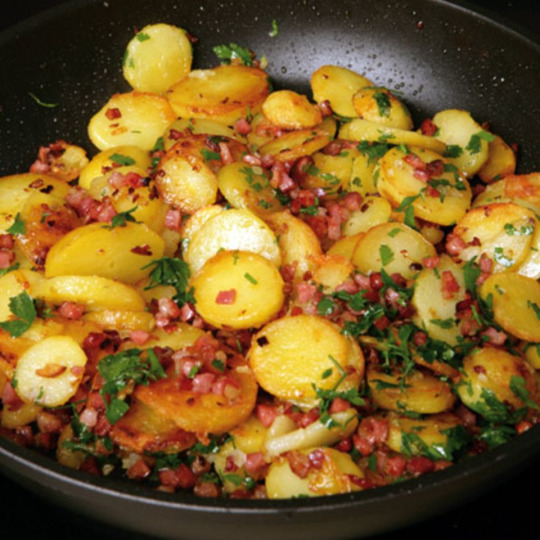
Brezel
Brezeln (pretzels) are baked pastries made from dough and shaped into a symmetrical knot. They are typically seasoned with salt, but can also have toppings such as cheese or seeds.
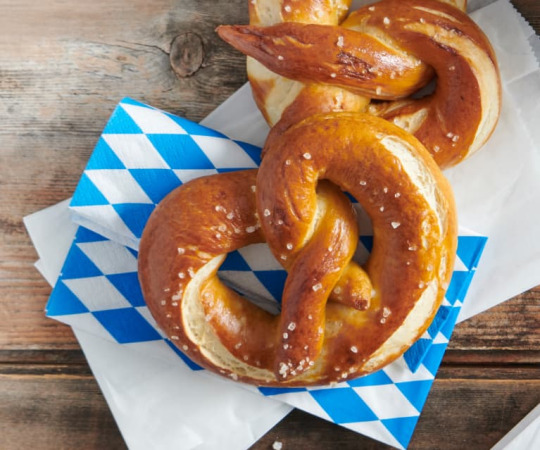
Brot
Brot (bread) comes in many different types, from white wheat bread (Weißbrot) to gray (Graubrot) to black (Schwarzbrot), which is actually dark brown rye bread. Some breads contain both wheat and rye flour and are called Mischbrot. Others have seeds such as linseed and sunflower seeds and are wholegrain (Vollkornbrot). Bread can also be made from spelt (Dinkelbrot), rye (Roggenbrot), or a mix of these with wheat.

Brötchen (bread rolls) are also very common and can be made from the same cereals and seeds as normal bread.
Currywurst
Currywurst is Berlin's most famous dish and consists of a pork sausage with ketchup and curry powder.
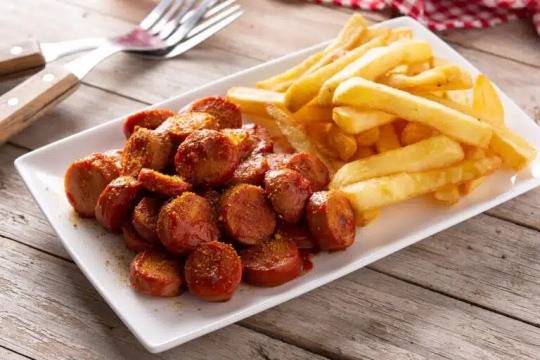
Eierschecke
Eierschecke, whose name is derived from a tripartite piece of clothing, consists of three layers: the bottom one is either a yeast dough or made with baking soda, the middle layer is a cream made of quark, vanilla, butter, egg, sugar, and milk, and the top one is made from eggs, butter, sugar, and vanilla pudding powder. It is a specialty from Saxony and Thuringia.

Fischbrötchen
A Fischbrötchen (fish bread roll) is a sandwich made with various fish, either pickled or fried, and onions, common in northern Germany.

Flammkuchen
Flammkuchen means "pie baked in the flames" and originates from Baden in Baden-Württemberg and the Palatinate in Rhineland-Palatinate. It is similar to a pizza with thin crust covered with crème fraîche, onions, and lardons.

Frikadellen
Frikadellen are flat-bottomed, pan-fried meatballs of minced meat. They are commonly eaten with pasta salad or potatoes, or in a bread roll with mustard.

Himmel und Erde
Himmel und Erde (heaven and earth) is a dish with mashed potatoes, stewed apples and fried blood pudding. Potatoes are also called Erdäpfel (ground apples), so it is a meal made with apples that grow above and under the earth. It is popular in the Rhineland in Rhineland-Palatinate and North Rhine-Westphalia, Westphalia in North Rhine-Westphalia, and Lower Saxony.
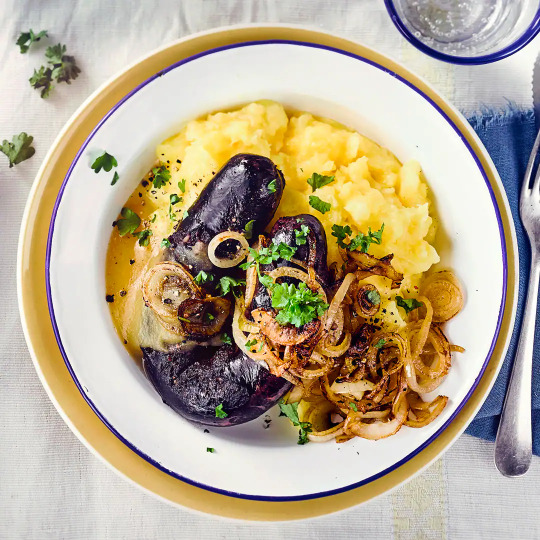
Kirschenmichel
Kirschenmichel is a kind of bread pudding made with cherries and served hot with vanilla sauce. It is typically eaten in Franconia in Bavaria and Thuringia, the Palatinate, Baden-Württemberg, and Hesse.

Klöße/Knödel
These dumplings are known as Klöße in northern, central, and western Germany and Knödel in southern Germany. They are usually made from flour, bread, or potatoes. There are different varieties, including dumplings made of ground liver or breadcrumbs.

Kohlroulade
A Kohlroulade (cabbage roll) consists of cooked cabbage leaves wrapped around a meat filling seasoned with garlic, onion, and spices. Rinderrouladen are similar but consist of bacon and onions wrapped in beef.

Labskaus
Labskaus is a dish made from corned beef, herring, mashed potatoes, and beetroot, served with a fried egg and a pickled cucumber. It is typically eaten in northern Germany.
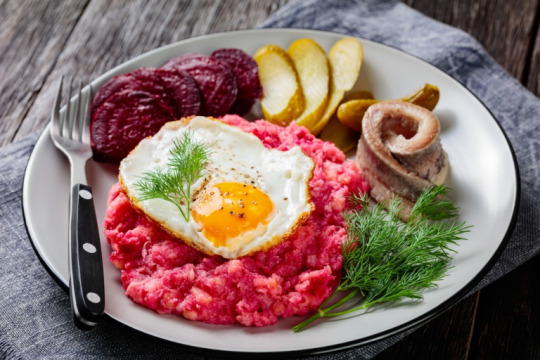
Leberkäse
Leberkäse ("liver-cheese") is eaten in Franconia, Saarland, and Swabia in Bavaria and Baden-Württemberg. It consists of beef, pork, and bacon that are finely ground and then baked as a loaf in a bread pan. It is served with an egg and mashed potatoes.

Leipziger Allerlei
Leipziger Allerlei was invented in Leipzig and consists of a mixture of peas, carrots, green beans, asparagus, morels, and celery. It may also contain broccoli, cauliflower, or corn. It is served with potatoes and a sauce made from crayfish butter, crayfish tails, and semolina dumplings.

Marmorkuchen
Marmorkuchen (marble cake) has a streaked appearance, achieved by lightly blending light and dark batter. It can be a mixture of vanilla and chocolate.

Maultaschen
Maultaschen ("mouth bags") are large meat-filled dumplings typical of Swabian cuisine. They can also be filled with spinach, onions, and spices and can be either served with broth or cut into slices and fried with eggs.

Pfefferpotthast
Pfefferpotthast (boiled meat pepper pot) is a traditional Westphalian stew made with beef, lard, onions, and spices. It is served with boiled potatoes and salad in the summer and pickled cucumbers and beetroot in the winter.
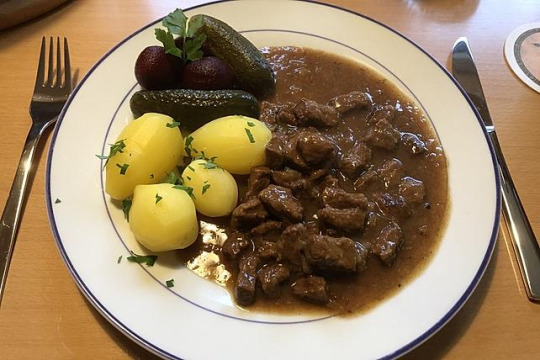
Pinkel mit Grünkohl
It is a dish made from slowly cooked kale served with Pinkel, a salty sausage eaten mainly in Bremen and Lower Saxony.
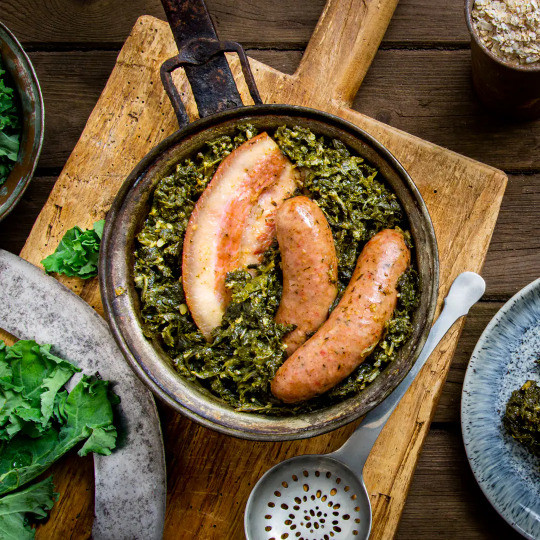
Quarkkäulchen
A Quarkkäulchen ("little quark ball") is a Saxon dish made from quark, mashed boiled potatoes, flour, an egg, and lemon peel. The dough is then baked in the form of a pancake and eaten hot with sugar and cinnamon or with fruit, whipped cream, and vanilla ice cream.

Reibekuchen
These potato pancakes are served with black bread, sugar beet syrup, or stewed apples. They are common in many areas of the country, but the name is characteristic to the Rhineland.

Rollmops
Rollmops ("rolled pug/fat young boy") are pickled herring fillets, rolled around a savory filling, usually consisting of onion and a pickle. It is a specialty from Berlin.

Sauerbraten
Sauerbraten is regarded as the national dish of Germany. It originally comes from the Rhineland and consists of large pieces of beef or horse meat, marinated in a spicy water-vinegar mixture before baking and served with Klöße.
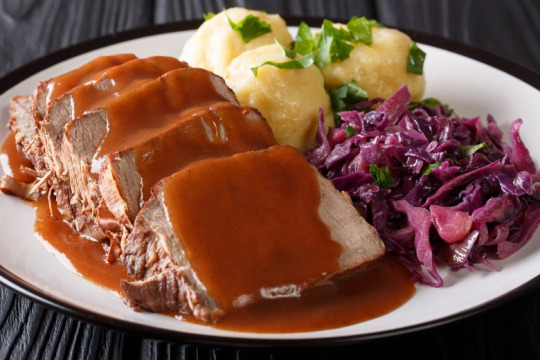
Sauerkraut
Sauerkraut is finely cut raw cabbage fermented by lactic acid bacteria.

Saumagen
Saumagen ("sow's stomach") is popular in the Palatinate and consists of a pork's stomach filled with pork, sausage meat, and potatoes. It is usually served with mashed potatoes or Bratkartoffeln and Sauerkraut.
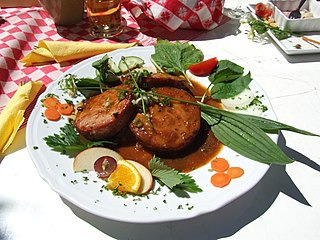
Schnitzel
A Schnitzel is a fried, breaded thin piece of meat, typically pork or beef. Although the most famous one is Wiener Schnitzel (Viennese style), there are other kinds, including Jägerschnitzel, with mushroom sauce; Rahmschnitzel, with cream sauce, and Zigeunerschnitzel, with a sauce made with tomato, bell peppers, and onion.

Schupfnudel
Schupfnudel are thick noodles typical of southern Germany. They are usually made from flour or potatoes and eggs and served with Sauerkraut.
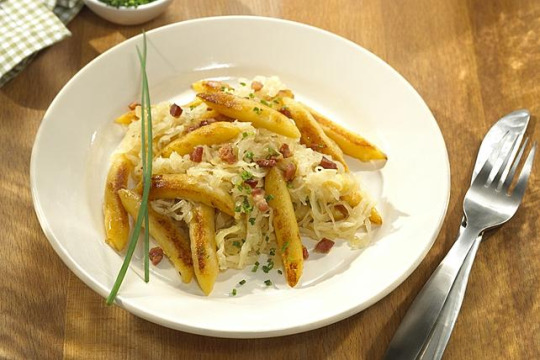
Schwarzsauer
Schwarzsauer ("black sour") is a North German blood soup with spices cooked in vinegar.

Schwarzwälder Kirschtorte
Black forest cake is a chocolate and whipped cream cake with a cherry filling and cherries on top.
Schweinshaxe
Schweinshaxe is a typical Bavarian dish of roasted ham hock served with Sauerkraut. A variation of this dish is known elsewhere as Eisbein ("ice leg"), in which the ham hock is pickled and slightly boiled.
Schwenkbraten
Schwenkbraten is a pork neck steak marinated in spices and onions. It is originally from the Saarland and grilled on a Schwenker, a grill that hangs on a chain over a wood fire.
Spaghettieis
Spaghettieis (spaghetti ice cream) is an ice cream dish made to resemble spaghetti. Vanilla ice cream is extruded through a modified Spätzle press to give it the appearance of spaghetti. It is placed over whipped cream and topped with strawberry sauce to simulate tomato sauce and either coconut flakes, grated almonds, or white chocolate shavings to represent Parmesan cheese.
Spätzle
Spätzle (little sparrow) are hand-made egg noodles, originally from Swabia. They are the main ingredient of several dishes, such as Käsespätzle (Spätzle with cheese) and Linsen mit Spätzle (lentils with Spätzle).
Streuselkuchen
Streuselkuchen ("crumb cake") is made of yeast dough covered with a sweet crumb topping (Streusel). The recipe originated in German Silesia.
47 notes
·
View notes
Text
Simple facts about Ancient Egypt (3)
And here is my last entry on various simple facts, trivia and elements about Ancient Egypt as a society and nation, to completement my mythology posts. (At least, my last entry of this summer). A bit of a warning, as usual, my sources might be a bit too oversimplified or a bit outdated, but that’s what I know about Ancient Egypt and feel free to correct me if anything is wrong!
We talked of great general facts about history and geography… We talked of the various jobs and social classes… Why not conclude with everyday life? And let’s begin with the heart of it all: food!
# Unless there were very bad crops leading to famines, the “common folk” of Ancient Egypt usually ate their fill and did not die of hunger. But while they ate their fill, they ate very simple and plain foods. The main element of the Egyptian alimentation was bread. Every meal had at its center the bread – sometimes served with onions (which was the most common and widespread vegetable of Egypt). Made with either spelt flour or barley, there were forty different types of Egyptian bread, usually of conic shape (since the molds for the bread were cone-shaped). Egyptians also ate a lot of vegetables and fruits: cucumbers, radishes, garlic, salads, cabbages, grapes, grenades, dates, figs… Egyptians especially ate a lot of lettuce: they believed it was an aphrodisiac and frequently ate some to augment their sexual desire. For great occasions, big holidays or special events, Egyptians added to their bread-and-plants meal either a fish or a duck, if the hunt/the fishing had gone well – because for every day folks, you had to get your own meat and fish. The meat coming from farms, the “raised” meat, was only a product for the wealthy and the upper-class.
# Egyptians took three meals a day: one in the morning, one in the beginning of the afternoon, and one in the evening. To eat, Ancient Egyptians sat on the ground, and didn’t use fork and knives, but either their own fingers, either a piece of bread.
# Egyptians were BIG beer drinkers. They drank more beer than water – and for good reasons! Because the water they obtained from either the Nile or wells tended to be filled with bacteria causing all sorts of disease and infections. So they preferred the much safer beer. Even kids drank beer every day – but hopefully it was a beer very low in alcohol. Egyptians created their beer with barley, and each family had to produce its own beer: a barley bread was broken into crumbs thrown into a big jar, filled with a mix of water and honey (or dates if you couldn’t have honey). The Egyptians then crushed and mixed the whole thing with their feet (yes, they entered into the jar and stomped it all). The gruel or porridge they obtained from this mix was then left to ferment for several days, before being eaten. Yes, “eaten”, not drank. Because Egyptian beer, on top of being much more nutritive than today’s beer, was also much thicker – it was more of a food than a drink.
# Since Egyptians had no sugar, they sweetened their meals with either honey or crushed dates. The wealthiest Egyptians drank wine, either red or white. And Egyptians already made foie gras! Yep, long before the French. But the funny thing is that they didn’t just do goose foie gras… They also made hyena foie gras.
# Egyptians, men and women, thought physical beauty was very important. If their clothes were typically simple and white, with not much color or ornament, they however had very varied and extravagant jewels, hairdos and makeup. Egyptian jewels came in the form of bracelets, rings, necklaces and earrings – the wealthy and the rich had jewels made of precious stones such as turquoise, lapis-lazuli, jasper or carnelian, while the poorer wore jewels made of enamel/faience.
# Egyptians wore most of their makeup around their eyes – they highlighted the shape of the eye by covering its borders in a black substance, either galena or kohl, before putting green makeup over their eyelids. Egyptians sometimes even dyed their eyelashes or eyebrows in green – and this wasn’t just a women’s habit, men also did that. The reason why Egyptians placed so much makeup on their eyes was because there were no sunglasses at the time, and the Egyptians desperately sought a way to protect themselves from the harsh rays of the sun, the dust carried by the desert’s wind, and the flies that tries to infect eyeballs. Galena and kohl had antiseptic properties, hence why Egyptians covered their eyes with it.
# While green was a very common makeup color, Egyptian women LOVED red makeup, made out of ochre. They used red makeup on their lips and on their cheek. They rather used henna to paint their fingernails and toenails – sometimes even their whole feet.
# In general, Egyptian household were known to collect a LOT of pots, jars, bottles and vials filled with creams, perfumes and various body oils. It wasn’t just pure vanity: Egyptians took great care of their skin because it could easily be damaged by the dryness and hotness of the Egyptian climate. Plus, Egyptians also had a great fear of aging, which was just as stigmatized as today, and so they tried to keep their skin looking as young as possible for as long as possible. In fact, one aspect of this fear of aging was the Egyptians’ fear of baldness. To fight it off, Egyptian men used all sorts of potions and products whose recipes we kept today, and that were made with the most improbable and repulsive ingredients. Donkey’s hooves, dogs’ legs, dates cores, snake fat or crocodile fat!
# Another fight against aging was the Egyptians’ fight against white or grey hair, that they constantly covered by either dying their hair black or wearing a wig. Egyptians were BIG fans of wigs – because they were considered a sign of wealth and upper status, since you needed a LOT of money to buy a wig. They were made out of real hair, decorated with various feathers, and plunged into bee wax to keep being straight and shining. However, to wear those wigs, Egyptians had to completely shave their real hair underneath…
# Ancient Egyptian houses were made out of mud bricks – all houses were made of mud bricks. You could only distinguish them by their size and their level of comfort, not by their material. A typical Egyptian house had three to four rooms, with thin walls and an uncovered ground – plus, the roof was always flat and doubling as a terrace. The houses of the nobility were much bigger (300 meters square roughly) , with much more rooms: they had several bedrooms, reception rooms, kitchen, pantries and workshop. Noble houses were also noted for having thick walls, and being covered in painted ceramic. To protect themselves from the heat, Egyptians built only a few windows, placed in high positions, and always towards the north – plus there were ventilation openings bult on the roof.
# Egyptian houses, however, were not very solid. They had no foundations, they just rested on the ground – and their bricks were made by leaving to dry out in the sun a mix of mud, stone and hay. If the wind was blowing too hard, cracks appeared in the walls, and if there was a flood, the walls simply melted and the house was swept away. So Egyptians often had to rebuild and repair their houses.
# Of course, no need to tell you that getting water to the house wasn’t easy – Egyptians had to go to the well two times a day to get water, and they kept it in large jars either in the courtyard or near the door. Only the rich could afford having big bathrooms and even toilets, and they were the only ones who built special passageways for dirty water to go outside of the house.
# Poor people in Egypt had the strict minimum when it came to furniture: a few stools to sit, a few mats to sleep on the ground, and a few baskets to put their clothes into. Rich people could afford tables (though they were low), beds, chairs and chests. But things such as wardrobes, high tables, or libraries did not exist in Ancient Egypt… There were couches however: But they were made out of bricks, and covered in cushion/pillows to make sure you didn’t break bone when you wanted to sit. To have light, Egyptians used a type of oil-lamp, made of a cup in which was placed a burning linen wick. Beds were also very uncomfortable, since it was a rectangle of wood, with cross-breams of woven reed, with no mattress whatsoever. There was no pillow, but a piece of wood on which Egyptians rested their heads. There was also no bedsheets whatsoever – all Egyptians could do was cover their beds in cushion or pieces of cloth. During the hottest nights, Egyptians slept on their roofs (which was also where they kept their stored grains and cereals).
# After talking of the house, let’s talk of the household. Egyptians were very BIG on love stories and romance in general, constantly painting or describing couples hugging or holding hands. While numerous marriages were arranged, a lot of Ancient Egyptians marriages were actually done out of love – something that was very unusual for the time, compared to the neighboring civilizations. People married young – around twenty years old for men, around fourteen years old for girls (because men were recognized as living longer than women in Ancient Egypt). The main purpose of the marriage was for the couple to make children, because it was believed that the child’s duty was to help and assist their parent when they grew old. So couples had lots of children – the average Egyptian family had ten children. When they died, couples were buried together in the same grave.
# A very interesting fact: women in Ancient Egypt were considered equal to men in the eyes of the law. This meant women had the same rights as men, could own money or wealth of their own, could go out without any chaperone and without their husband being present… In fact, if a woman was abused or harmed by her husband, she could go to the tribunal, and the husband would be punished by a severe beating – up to a hundred hits with a wooden rod. And if the abusive husband harmed his wife again, she could demand a divorce and to have money given to her.
# Because yes, divorce existed in Ancient Egypt! Some couples, when they married, wrote a contract, but it was not obligatory – and usually these contracts were only written by couples who were married together for a few years now. That’s because the contract’s function was to establish to who belonged what in the household (the furniture, the clothes, the money, the house) and it was only used to take care of the topic of heirs and inheritance. There was no official religious or bureaucratic ceremony for the marriage – no priest was called, no bureaucrat of the town was called, there was no trip to the temple… The only thing that “validated” a marriage was the fact that a man and a woman lived together as a couple in a same house – in fact, a woman was officially married when she first placed her foot inside the house of the boy she wanted to be the wife of. If a couple didn’t like each other anymore or couldn’t stand each other, they just had a divorce. Well… if they could afford it. Because the Egyptian divorce required for the couple to split their belongings between each other, which was a cause of many feuds and disputes. Typically the divorced woman returned to her parent’s house, until she could find a new husband.
# Unlike what some people believe, there was no “harem” and no polygamy among Egyptian couples – it was a strictly pharaonic habit. The regular folks of Ancient Egypt could only have one wife or one husband. Similarly, while the pharaoh was allowed and encouraged to marry within his own family, incest was forbidden for the regular inhabitants of Egypt – siblings could not marry, and parents could not marry their children.
# The love Egyptians had for cats was so great that, when a cat died within a house, all of the household grieved, and every member of the family (because a house’s cat was thought to be part of the family) shaved their eyebrows.
# Children are taken care of by their mother up to six years old or so. During this time, the child’s life is mostly just playing around with their siblings and their neighbors in the streets. Starting at six years old, the boys become their father’s charge, while the mothers stay with their mother. Boys are taught either their father’s job, or were sent to school, while girls learned from their mother how to take care of the house, or how to do farm work. But for the “school” part, it was only for the boys of rich family, since school was an elitist organization in Ancient Egypt – school was the only way for Egyptians to become scribes, scientists, priests or ministers. All those that didn’t go to school were forced to work alongside their parents – yes, even at five or six years old! Child labor was very common. Little boys could be found sculpting stone, doing woodwork, painting, shaping jewels, building houses, while little girls learned how to weave, how to brew beer, how to grind grains, and of course if the child belonged to a farmer’s household, they were seen working in the fields.
# Children often had a shaved head to avoid the plague that were the lice. Children could only keep one lock of hair, that often grew into a braid – it was the “lock of childhood”, or “children’s braid”, a braid which was cut off at fourteen years old.
# There was no difference between boys and girls when a baby was born: both were welcomed with great joy and festivities. As I said before, women had the same rights as men, and so girls were just as beloved as boys.
# There were a lot of toys back in Ancient Egypt, for young children (below six) to play with. Balls made of woven reed or stitched cloth, rattles, stone spinning tops, earthenware dolls (for girls), and even all sorts of wooden animals with articulated limbs and jaws. In fact, the same way young children of Europe often played with miniature horses or horses on wheels, Egyptian kids (who had no idea what a horse was since they weren’t from the region) rather had lions with wheels, or wheeled crocodiles.
# And most of the time children were left naked. This was actually part of a strange obsession with cleanliness that possessed Ancient Egyptians: people thought that leaving the child naked would allow the clothes to keep clean and thus avoid unnecessary laundry. However, children were forced to wear jewels, especially ear-rings (be it boys or girls, both had their ears pierced). Children were only asked to wear clothes when the temperatures went low and the air was a bit chilly – they then wore a sleeved tunic.
#simple facts about ancient egypt#women's rights in ancient egypt#ancient egypt#ancient egyptian family#ancient egyptian diet#makeup throughout history
13 notes
·
View notes
Text
Today I'm home alone and I was like "I can eat what I want, all the disgusting shit my parents would judge me heavily for" and of course instead I made myself an hearty meal of spelt salad
10 notes
·
View notes
Text
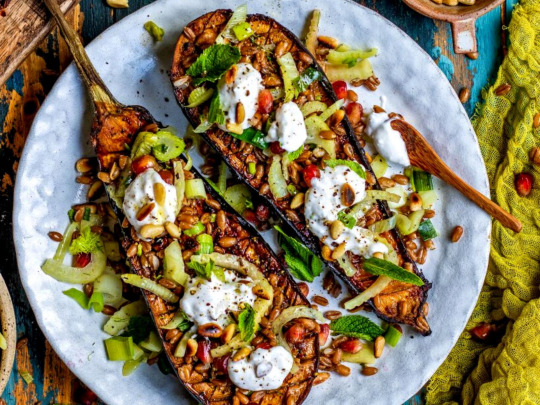
Miso Eggplant with Fennel & Spelt Salad (Vegan)
#vegan#lunch#dinner#rice bowl#fennel#spelt#eggplant#miso#garlic#ginger#mint#pistachios#green onion#maple syrup#sesame oil#vegan yogurt#pomegranate
10 notes
·
View notes
Text
(reblog if u feel so inclined ʕ ● ᴥ ●ʔ )
edit: sorry i forgot it was spelt vanilla creamee my bad!
8 notes
·
View notes
